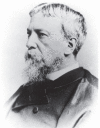Silas Weir Mitchell, MD, LLD, FRC: Neurological Evaluation and Rehabilitation of the Injured Upper Extremity
- PMID: 31014111
- PMCID: PMC7818038
- DOI: 10.1177/1558944719843643
Silas Weir Mitchell, MD, LLD, FRC: Neurological Evaluation and Rehabilitation of the Injured Upper Extremity
Abstract
Appreciating the history of Hand Surgery is part of what most of us enjoy about our profession. Most of us know that Silas Weir Mitchell, MD, coined the terms "Causalgia" and "Phantom Limb," yet few of us know that our present-day evaluation of the sensory and motor function of the hand and some of our rehabilitation methods for motor palsy were introduced by Mitchell as he worked, scholarly, in Turner's Lane Hospital, the first hospital devoted to nerve injuries, to understand Civil War gunshot wounds related to musket ball. Mitchell's contributions to neurosensory and motor evaluation were reviewed by reading his historical publications. Mitchell's described cervical sympathetic injury Horner's Syndrome), sensory recovery preceding motor recovery after proximal nerve injury, that more sensory information can be perceived by applying greater pressure, importance of passive joint movement to prevent contracture, value of electrical stimulation after motor palsy, value of rest to facilitate healing, ability of 1- and 2-point sensory testing to evaluate sensibility, value of testing temperature to understand neuropathology, importance of experimental peripheral nerve surgery to clinical care, recorded muscle strength by manual evaluation, staged degree of nerve injury, described Saturday night and crutch palsy, and first described Hoffmann-Tinel sign. Mitchell made signifiant and seminal observations, that have largely gone unrecognized and that we use today in care of the injured upper extremity.
Keywords: Causalgia; Phantom Limb; Silas Weir Mitchell; electric stimulation; radial neuropathy.
Conflict of interest statement
Figures


References
-
- Learmonth J. The principle of decompression in the treatment of certain diseases of peripheral nerves. Surg Clin North Am. 1933;13:905-913.
-
- Learmonth J. A technique for transplanting the ulnar nerve. Surg Gyn Obst. 1942;75:792-793.
-
- Dellon AL, Amadio PC., James R. Learmonth: the first peripheral nerve surgeon. J Reconstr Microsurg. 2000;16(3):213-217. - PubMed
-
- Dellon AL. The sensational contributions of Erik Moberg. J Hand Surg Br. 1990;15(1):14-24. - PubMed
-
- Dellon A. Proprioception. In: Joint Denervation: Anatomic Atlas of Surgical Techniques. Springer Nature; 2019:13-22.
Publication types
MeSH terms
LinkOut - more resources
Full Text Sources

